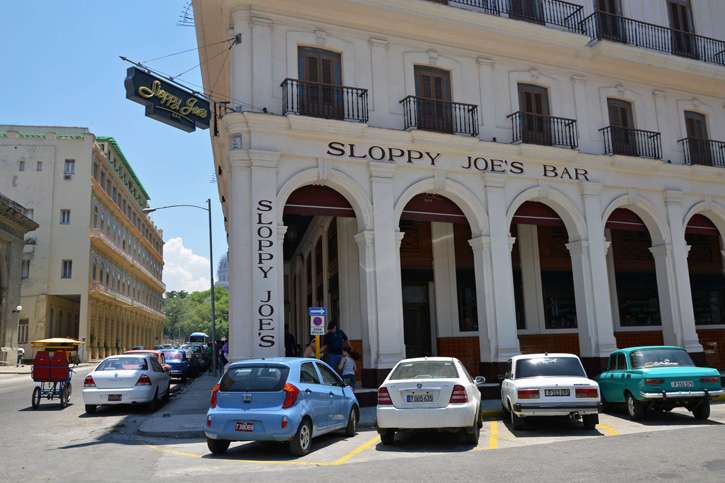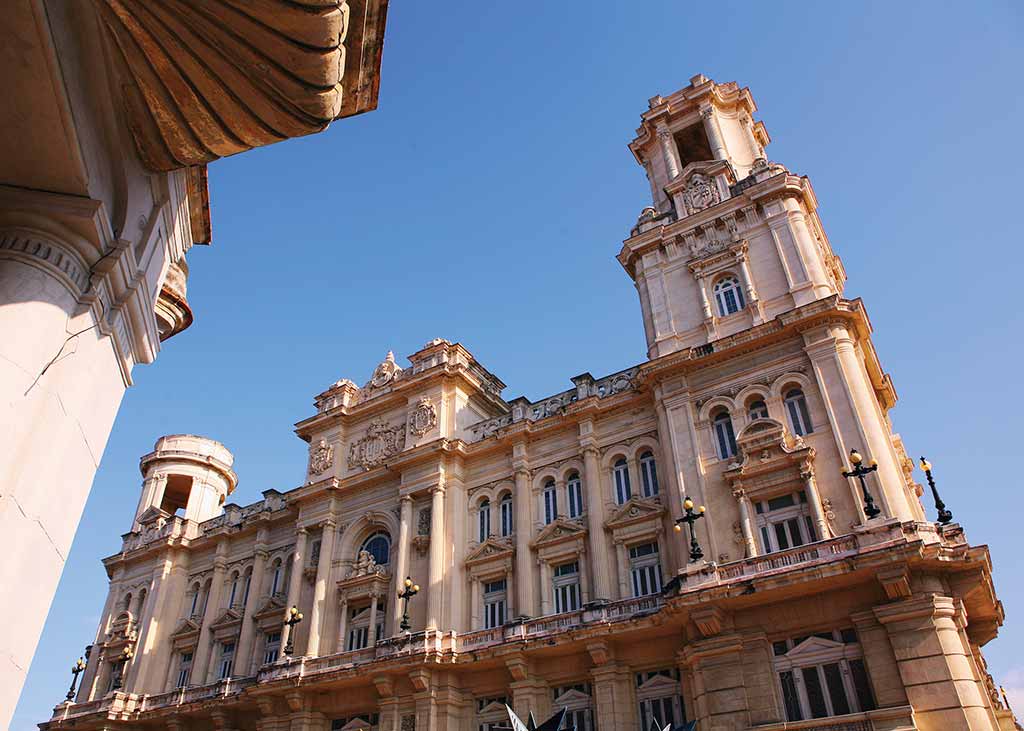Calle Agramonte, more commonly referred to by its colonial name of Zulueta, parallels the Prado and slopes gently upward from Avenida de los Estudiantes to the northeast side of Parque Central. Traffic runs one-way uphill.
The Rincón de los Cretinos (Corner of Cretins) pokes fun at Batista, Ronald Reagan, and George Bush.At its north end is the Monumento al General Máximo Gómez. This massive monument of white marble by sculptor Aldo Gamba was erected in 1935 to honor the Dominican-born hero of the Cuban wars of independence who led the Liberation Army as commander-in-chief. Generalissimo Gómez (1836-1905) is cast in bronze, reining in his horse.One block north of Parque Central, at the corner of Zulueta and Ánimas, a mosaic on the paving announces your arrival at Sloppy Joe’s, commemorated as Freddy’s Bar in Hemingway’s To Have and Have Not. In 2013 it reopened its doors after lying shuttered, near-derelict.

Sloppy Joe’s, a once-legendary bar, was founded in 1918 by José Abel, who turned a dilapidated and messy grocery store into “Sloppy Joe’s.” It reopened in 2013 after decades in ruins. Photo © fionadeaton/123rf.
The old Cuartel de Bomberos fire station houses the tiny Museo de Bomberos (Museum of Firemen, Zulueta #257, e/Neptuno y Ánimas, tel. 07/863-4826, Tues.-Fri. 9:30am-5pm, free), displaying a Merryweather engine from 1894 and antique firefighting memorabilia.
Immediately beyond the Museo Nacional de Bellas Artes and Museo de la Revolución is Plaza 13 de Mayo, a grassy park named to commemorate the ill-fated attack of the presidential palace by student martyrs on March 13, 1957. At the base of Zulueta, at the junction with Cárcel, note the flamboyant art nouveau building housing the Spanish Embassy.
The ornate building facing north over Plaza 13 de Mayo was initiated in 1913 to house the provincial government. Before it could be finished (in 1920), it was earmarked as the Palacio Presidencial (Presidential Palace), and Tiffany’s of New York was entrusted with its interior decoration. It was designed by Belgian Paul Belau and Cuban Carlos Maruri in an eclectic style, with a lofty dome. Following the Revolution, the three-story palace was converted into the dour Museo de la Revolución (Museum of the Revolution, Refugio #1, e/ Zulueta y Monserrate, tel. 07/862-4091, daily 10am-5pm, CUC6, cameras CUC2, guide CUC2). It is fronted by a SAU-100 Stalin tank used during the Bay of Pigs invasion in 1961 and a semi-derelict watchtower—Baluarte de Ángel—erected in 1680.

The Salón de los Espejos (the Mirror Room) is a replica of that in Versailles (replete with paintings by Armando Menocal). Photo © Tony Hisgett, licensed Creative Commons Attribution.
The marble staircase leads to the Salón de los Espejos (the Mirror Room), a replica of that in Versailles (replete with paintings by Armando Menocal); and Salón Dorado (the Gold Room), decorated with gold leaf and highlighted by its magnificent dome.
Rooms are divided chronologically, from the colonial period to the modern day. Maps describe the progress of the revolutionary war. Guns and rifles are displayed alongside grisly photos of dead and tortured heroes. The Rincón de los Cretinos (Corner of Cretins) pokes fun at Batista, Ronald Reagan, and George Bush.
At the rear, in the former palace gardens, is the Granma Memorial, preserving the vessel that brought Castro and his revolutionaries from Mexico to Cuba in 1956. The Granma is encased in a massive glass structure. It’s surrounded by vehicles used in the revolutionary war: armored vehicles, the bullet-riddled “Fast Delivery” truck used in the student commandos’ assault on the palace on March 13, 1957 (Batista escaped through a secret door), and Castro’s Toyota jeep from the Sierra Maestra. There’s also a turbine from the U-2 spy plane downed during the missile crisis in 1962, plus a naval Sea Fury and a T-34 tank.
The Cuban section of the Museo Nacional de Bellas Artes (National Fine Arts Museum, Trocadero, e/ Zulueta y Monserrate, tel. 07/863-9484 or 07/862-0140, Tues.-Sat. 9am-5pm, Sun. 10am-2pm, entrance CUC5, or CUC8 for both sections, guided tour CUC2) is housed in the soberly classical Palacio de Bellas Artes.

Museo Nacional de Bellas Artes. Photo © Christopher P. Baker.
The museum features an atrium garden from which ramps lead up to two floors exhibiting a complete spectrum of Cuban paintings, engravings, sketches, and sculptures. Works representing the vision of early 16th- and 17th-century travelers merge into colonial-era pieces, early 20th-century Cuban interpretations of Impressionism, Surrealism, and works spawned by the Revolution. Fantastic!
Excerpted from the First Edition of Moon Havana.